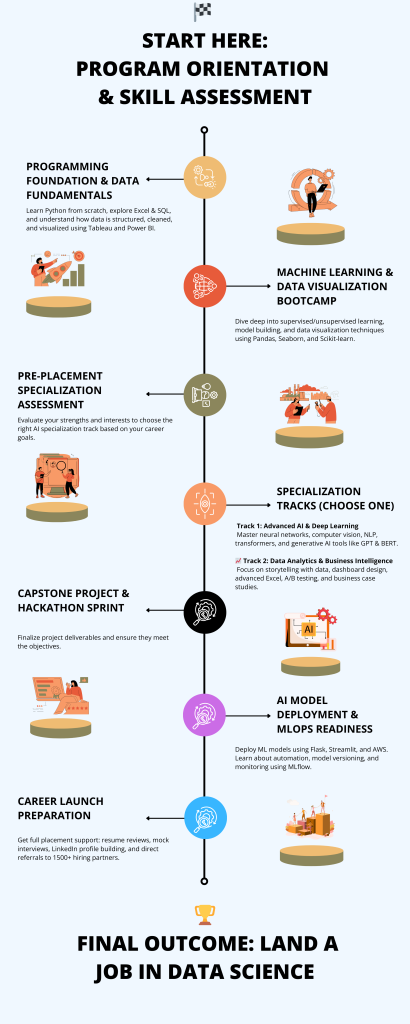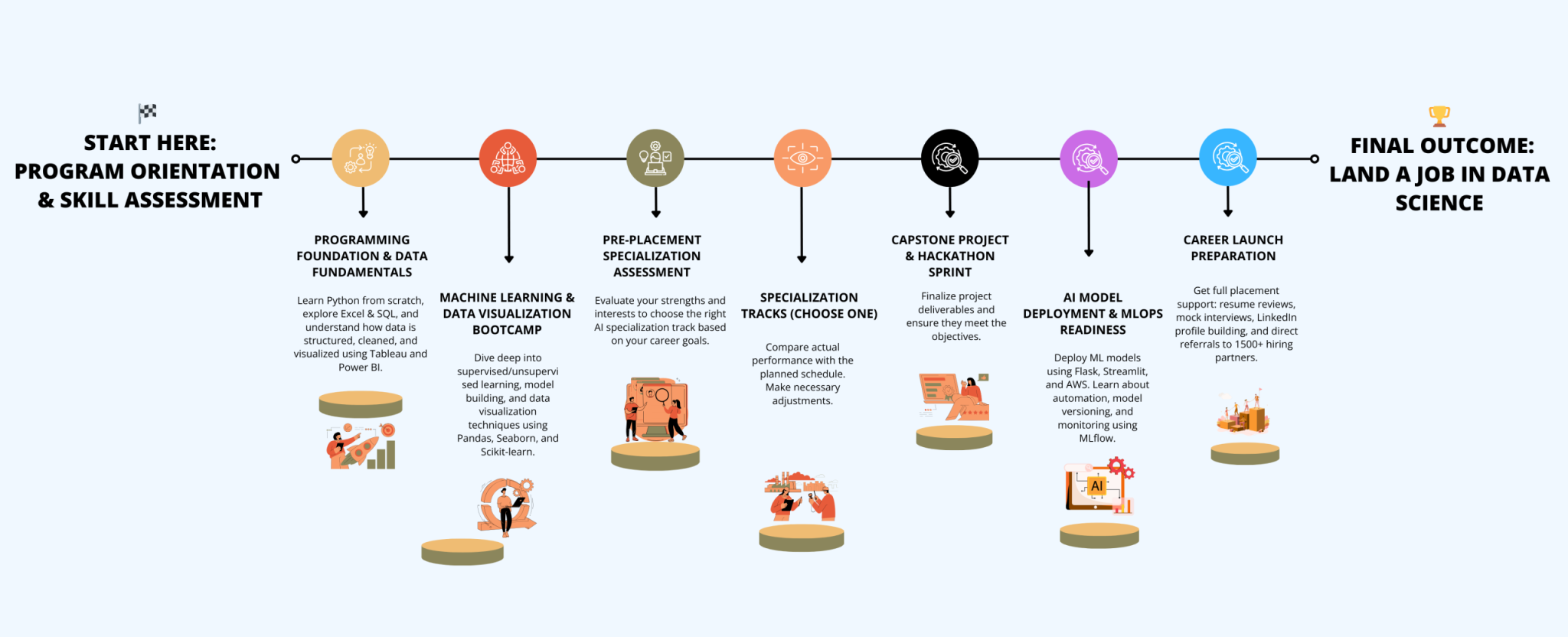
- Explore Courses New ▶
- Data Science ▶
- Investment Banking Program ▶
- Cyber Security Program ▶
- Full Stack Program ▶
- Business Analytics ▶
- Success Stories
- Contact Us
- About Us
- Blog
- Enroll Now
PG Program in Data Science with Job Guarantee
Master data science skills with industry experts and get guaranteed job placement or your money back.
Program Duration
7 Months
Learning Format
Online Live
Placement Assistance
100% Guaranteed
PG Program in Data Science with Job Guarantee
Master data science skills with industry experts and get guaranteed job placement or your money back.
Program Duration
7 Months
Learning Format
Online Live
Placement Assistance
100% Guaranteed
Trusted By Leading Companies
No Content
Join the Most In-Demand PG Data Science Job Guarantee Program
Master the real-world application of Data Science and Artificial Intelligence to build smart, scalable models that drive business success. This 100% Job Guarantee program is designed for fresh graduates and working professionals aiming to launch a high-impact career in the AI and Data Science space.
Gain hands-on experience with AI tools, machine learning algorithms, and deep learning techniques while solving real industry problems. Prepare to step confidently into roles like Data Scientist, AI Engineer, ML Engineer, and more—all backed by practical project work and full placement support.
Industry-Relevant Curriculum
Comprehensive curriculum covering Python, Machine Learning, Deep Learning, NLP, and Big Data technologies.
Job Guarantee
Get placed in a data science role within 6 months of graduation or receive a full refund of your program fee.
Live Online Classes
Learn from top industry experts through interactive live sessions with real-time doubt resolution.
1:1 Mentorship
Personalized guidance from industry mentors to help you navigate your learning journey effectively.
Career Support
Resume building, interview preparation, and exclusive access to job opportunities with top companies.
Capstone Projects
Work on real-world projects to build a strong portfolio that showcases your data science expertise.
Comprehensive Course Curriculum
Our industry-aligned curriculum is designed by experts to help you master the most in-demand data
science skills and prepare you for a successful career.
Data Foundations & Business Tools
This foundational module sets the tone for your entire Data Science journey. The goal is to ensure that every learner is confident in working with raw data—structuring it, cleaning it, transforming it, and deriving meaningful insights. You’ll begin with spreadsheet tools like Excel and Google Sheets, progress into structured querying with SQL, and learn to work with relational databases. From there, you’ll explore modern data visualization tools like Tableau and Power BI, which are critical for communicating data-driven findings.
What you'll learn:
- Python programming fundamentals
- Descriptive and inferential statistics
- Data manipulation with NumPy and Pandas
Course Content
Excel
Introduction to Excel, formulas, pivot tables, charts, statistical functions, dashboards, What-if analysis, Google Sheets for collaboration
QL
Basics of databases, CRUD operations, joins, aggregations, filtering, subqueries, window functions, CTEs
Databases
Understanding relational databases (MySQL/PostgreSQL), indexing, normalization
Power BI/Tableau
Connecting data, calculated fields, dashboards, KPIs, LOD expressions, visual storytelling
Data Wrangling Basics
Handling missing values, data reshaping, column transformations, type conversions
Programming for Data Science
Python is the most widely used programming language in the data world—and for good reason. In this module, you’ll gain a strong grip on Python fundamentals along with practical exposure to key libraries used in data science.
You’ll start with the basics—data types, loops, functions—and move into advanced concepts like OOP, list comprehensions, and file handling. From there, we’ll explore data-focused libraries like NumPy and Pandas for efficient computation and data manipulation, and data visualization with Matplotlib and Seaborn. You’ll also gain hands-on experience with Git and GitHub for version control—an essential skill for collaborative data science projects.
What you'll learn:
- Python programming fundamentals
- Descriptive and inferential statistics
- Data manipulation with NumPy and Pandas
Course Content
Python Basics
Variables, loops, conditionals, functions, data structures (lists, tuples, dictionaries, sets)
Advanced Python
OOP concepts, file I/O, error handling, comprehensions
NumPy & Pandas
Arrays, vectorized operations, DataFrames, filtering, merging, grouping, reshaping
Visualization Librarie
Matplotlib (plots, axes, subplots), Seaborn (heatmaps, pairplots, boxplots)
Version Control
Git basics, creating repos, branching, pull requests, working with GitHub
Statistics, Probability & EDA
This module focuses on the statistical thinking behind data science. It’s where you’ll learn to analyze and interpret data distributions, draw inferences, and test hypotheses. You’ll also conduct in-depth exploratory data analysis (EDA) to uncover trends, patterns, and insights hidden in the data.
Statistical literacy is key to becoming a successful data scientist. You’ll learn about descriptive and inferential statistics, common probability distributions, and how to validate assumptions with hypothesis testing. The module concludes with hands-on EDA using Python, where you’ll apply visual and statistical techniques to real datasets.
What you'll learn:
- Python programming fundamentals
- Descriptive and inferential statistics
- Data manipulation with NumPy and Pandas
Course Content
Descriptive Statistics
Overview of data science field, career paths, and industry applications
Inferential Statistics
Variables, data types, control structures, functions, and object-oriented programming
Probability
Linear algebra, calculus, and probability theory fundamentals
Hypothesis Testing
Descriptive statistics, probability distributions, hypothesis testing, and confidence intervals
Exploratory Data Analysis
NumPy arrays, Pandas DataFrames, data cleaning, and preprocessing techniques
Machine Learning & Model Building
In this module, you’ll begin building real predictive models. You’ll learn the theory and intuition behind key algorithms, and more importantly, how to implement them from scratch using Python libraries like Scikit-learn.
You’ll explore supervised and unsupervised learning, develop your first classification and regression models, and understand how to evaluate performance. The module also includes tuning methods like grid search and cross-validation and ensemble learning techniques like bagging and boosting.
What you'll learn:
- Python programming fundamentals
- Descriptive and inferential statistics
- Data manipulation with NumPy and Pandas
Course Content
Supervised Learning
Overview of data science field, career paths, and industry applications
Unsupervised Learning
Variables, data types, control structures, functions, and object-oriented programming
Model Evaluation
Linear algebra, calculus, and probability theory fundamentals
Model Tuning
Descriptive statistics, probability distributions, hypothesis testing, and confidence intervals
Ensemble Techniques
NumPy arrays, Pandas DataFrames, data cleaning, and preprocessing techniques
AI, Deep Learning & NLP
This module takes you deeper into artificial intelligence, focusing on neural networks, deep learning, and natural language processing (NLP). You’ll explore real-world use cases such as image classification, sentiment analysis, and chatbot development.
Starting from the basics of neural networks and deep learning frameworks like TensorFlow and Keras, you’ll build up to advanced concepts like RNNs, transformers, and BERT for NLP tasks. You’ll also cover time series forecasting and recommendation systems used widely in tech companies.
What you'll learn:
- Python programming fundamentals
- Descriptive and inferential statistics
- Data manipulation with NumPy and Pandas
Course Content
Neural Networks
Overview of data science field, career paths, and industry applications
Natural Language Processing
Variables, data types, control structures, functions, and object-oriented programming
Transformers
Linear algebra, calculus, and probability theory fundamentals
Time Series Forecasting
Descriptive statistics, probability distributions, hypothesis testing, and confidence intervals
Recommendation Systems
NumPy arrays, Pandas DataFrames, data cleaning, and preprocessing techniques
Deployment, Projects & Career Readiness
In the final module, you’ll bring everything together—deploying models, building machine learning pipelines, and presenting your capstone project. You’ll also receive career support to help you stand out in the job market.
You’ll learn how to wrap your ML models into APIs using Flask, host them using platforms like Streamlit or AWS, and understand the basics of MLOps. Finally, we’ll help you craft your resume, build a strong LinkedIn profile, and prepare with mock interviews for data science roles.
What you'll learn:
- Python programming fundamentals
- Descriptive and inferential statistics
- Data manipulation with NumPy and Pandas
Course Content
Deployment
Building REST APIs with Flask, deploying models with AWS or Streamlit
MLOps & Pipelines
Batch vs real-time, pipeline orchestration, model monitoring basics
Capstone Projects
Real-world applications in BFSI, Healthcare, Retail, E-commerce
Career Preparation
Resume & LinkedIn optimization, mock interviews, placement support
Learning Journey


👩🏫 Meet Your Data Science Mentors
What role does a Data Scientist play?
Data Scientist
Analyze data and create predictive models using AI.
Data Analyst
Interpret datasets to support informed business decision making.
Machine Learning Engineer
Build, train, and optimize ML models for automation tasks.
Data Engineer
Develop data pipelines and manage scalable infrastructure systems.
AI Research Scientist
Invent advanced algorithms for artificial intelligence innovation.
Business Intelligence Analyst
Transform complex data into business insights and visual dashboards.
Statistician
Use statistical techniques to interpret and explain data findings.
Data Architect
Design and manage enterprise-level data systems and databases.
Big Data Engineer
Work with huge datasets using Hadoop and Spark technologies.
Master 25+ Essential Skills to Become a Job-Ready Data Scientist
Work Hands-On With the Most Powerful Tools in Data Science
Python

NumPy
Pandas
Jupyter
TensorFlow

Scikit-Learn
SQL
Matplotlib
Seaborn

Tableau
R
Linux
Apply Skills in Real-World Industry Projects
Customer Segmentation for Personalized Banking
Use K-means clustering to segment customers based on demographics and transactions. Present insights via dashboards.
Tools: SQL, Python (Pandas, Scikit-learn), Tableau Skills: Clustering, EDA, Dashboarding Sector: BFSIProduct Pricing Strategy Optimization
Analyze competitor pricing data to determine optimal product pricing using regression models.
Tools: Excel, Python (StatsModels), Power BI Skills: Regression, Analytics, Visualization Sector: RetailDisease Risk Prediction
Build a classification model to predict the likelihood of heart disease from patient data.
Tools: Python (Scikit-learn), Matplotlib Skills: Classification, Feature Engineering Sector: HealthcareForecasting Furniture Sales
Use time series models to forecast monthly furniture sales using historical data.
Tools: Python (ARIMA, Prophet), Excel Skills: Time Series Forecasting, Data Transformation Sector: E-commerceTaxi Fare Prediction
Predict taxi fares using regression models with ride distance, time, and location data.
Tools: Python (XGBoost, Linear Regression), Seaborn Skills: Feature Engineering, Regression Sector: Transport/LogisticsReal Estate Price Prediction
Use regression to predict housing prices and deploy the model using Streamlit.
Tools: Python, Pandas, Scikit-learn, Streamlit Skills: Model Deployment, Data Cleaning Sector: Real EstateFraud Detection in Financial Transactions
Detect fraudulent credit card transactions using a binary classification model.
Tools: Python, Scikit-learn, Random Forest Skills: Anomaly Detection, Classification Sector: FintechClimate Change Pattern Analysis
Visualize climate change trends using temperature and emission datasets.
Tools: Python (Pandas, Seaborn), Power BI Skills: Trend Analysis, Data Aggregation Sector: Environment/ResearchCareer Services to Get You Hired
Dedicated career support to transform your skills into a successful data science career.
Our Hiring Partners




🎓 Earn Your Industry-Endorsed PG Certification


Hear from Our Alumni
Real stories of career transformations with our Data Science program.

Rajesh Kumar
Analyst → Data Scientist
"The hands-on projects and expert mentorship helped me successfully transition from an Analyst role to a Data Scientist within 6 months!"

Sneha Patel
Software Engineer → ML Engineer
"The AI modules and career coaching helped me land a dream ML engineer role within 4 months after completion."

Amit Sharma
Finance Manager → Data Analyst
"I gained valuable skills in analytics and visualization that helped me switch from finance to data analysis in retail."

Priya Desai
Marketing Executive → Data Scientist
"From marketing to data science, the course enabled me to understand data-driven decision-making and boosted my career."

Vikram Singh
IT Support → Data Engineer
"Practical labs and deployment techniques helped me shift from IT support to a confident Data Engineer role."

Neha Jain
Graduate → Data Scientist
"From no experience to a full-time Data Scientist role within 8 months — the best investment I ever made!"

Manish Verma
Researcher → Data Scientist
"Advanced AI modules and practical projects helped me transition from academia to the data science industry."

Pooja Reddy
MBA Graduate → Data Analyst
"Career mentoring and resume workshops were invaluable in helping me secure my first analyst role in data."
- Course details
- Support
- Placement Assistance
- Payment Options
FAQs: PG Data Science Job Guarantee Program
Q. Who can join this program?
Graduates from any discipline with a strong interest in data analytics and programming can enroll.
Q. What is the duration of the program? +
Q. Is prior coding experience necessary? +
Q. What tools will I learn? +
Q. Will I get doubt-clearing support? +
Q. Are live sessions recorded? +
Q. How do I connect with mentors? +
Q. Is there a community or peer group? +
Q. Is job guarantee real? +
Q. What companies will I get placed in? +
Q. What if I don't get placed? +
Q. Do I get interview prep? +
Q. What is the program fee? +
Q. Are there EMI or part payment options? +
Q. Can I pay after placement? +
Q. Are there any discounts available? +
Ready to Transform Your Career?
Join thousands of successful professionals who have advanced their careers
with BookMyLearning










